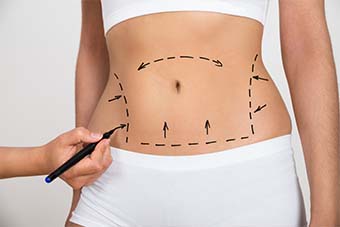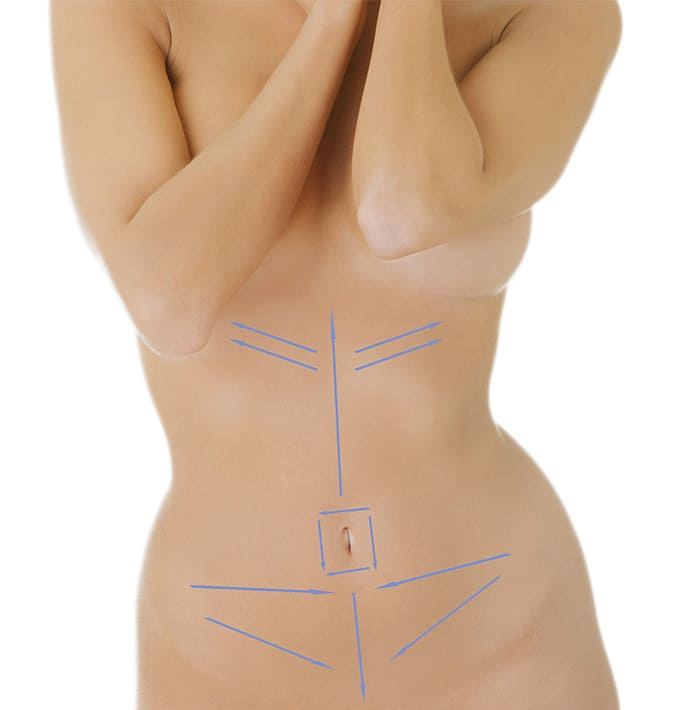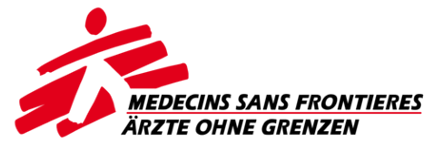Abdominoplasty - Your professional abdominoplasty in the Czech Republic
With an abdominoplasty superfluous skin and fat at the belly can be permanently removed. If necessary it is possible to combine this surgery with a small liposuction at the hips. We are happy to inform you. The scars can usually easily be hidden under the underwear or a bathing suit.
The desire to have an even and flat belly can occur because of many different reasons. In many cases the belly area can get deformed through pregnancy and decreases in weight. The decrease in weight can be a reason for both men and women to decide in favor of an abdominoplasty. In case there is remaining skin at your belly area this can’t be solved with sport and healthy food. In this case an abdominoplasty is advisable.
Thanks to our experienced doctors an abdominoplasty can improve the aesthetic appearance of your belly. Thereby, skin and fat can be removed by our cosmetic surgeons in the Czech Republic. We support you in all belongings concerning your abdominoplasty.

Abdominoplasty from 1.500 €
Brief information about Abdominoplasty
Narkosis
general anaesthetic
Duration
2 – 3 hours
Stay in the clinic
2 days
Compression clothes
6 weeks day and night
Sport
after 6 weeks
Sun / Solarium
after 6 months
Employability
after about 2 weeks
Things to know about your Abdominoplasty operation in the Czech Republic
How much does Abdominoplasty cost?
Abdominoplasty without belly button dislocation
from 1.500 €
Abdominoplasty with belly button dislocation
from 1.600 €
Abdominoplasty with liposuction *
from 1.950€
(* incl. suction on the lower abdomen)
Before the Abdominoplasty
About 4 weeks before the surgery, you should reduce smoking. Moreover alcohol should be avoided. About 2 weeks before the surgery you should not take anticoagulants (Aspirin, acetylsalicylic acid containing drugs). In case you are a woman and you are on the birth control pill you should stop taking it for 3 weeks before the surgery.
In order to conduct the surgery you need a blood count and an electrocardiogram. In case you want to have the results before your appointment with your surgeon, your general practitioner can provide you with them. In this case you can bring the results with you (the results should not be older than two weeks). However, it is not mandatory to conduct these tests beforehand. The tests that you need in order to decide if you are ready for the operation will also be made directly at the clinic.
Process of the Abdominoplasty
Before the surgery you will be informed during a detailed consultation talk on how the surgery is done. During this consultation you will be informed about possible complications and risks. It is advisable that you write down all the questions you have concerning the surgery, before your appointment at the clinic.
The surgery will be conducted under general anaesthesia. Before the anaesthesia you will be advised by an anaesthetist about the risks, complications and the course of the narcosis. The anaesthetist will be present during the surgery. During narcosis risks or complications can occur, depending on previous diseases and your general state of health.
Before the surgery the affected areas are marked on the skin. For an abdominoplasty the incision is placed just above the pubic hair. The incision runs from one pelvic bone to the other. The belly button is separated from the surrounding tissue. In order to lift abdominal muscles and fix them to the new position, the skin of the region from the abdominal wall to the rips is lifted. Usually, the waste can be made slimmer and formed.
With the lifting of the abdominal wall (partial lift) the incision is usually much smaller and separating the belly button from the surrounding tissue may be avoided. During the surgery thin drainages are inserted. After about 2-3 days the drainages are removed, depending of the scale of the surgery. The wound is closed by a wafer-thin suture. Right after the surgery you get compression clothing which you have to wear for 4-6 weeks day and night. The wound healing and the lifting effect can be improved by wearing the compression clothing.
After the Abdominoplasty
One day after the surgery you will have a follow-up examination. Please only take the drugs that you get from the doctor in the clinic. To make it easier for you, you should have an accompanying person with you, as you should not drive yourself when travelling home. Make sure that you take enough breaks.
The stitches can usually be taken out after 10-14 days by your general practitioner. Swellings, haematoma, and possible feelings of numbness subside after a short period of time. For your well-being you should allow yourself a period of recovery of two weeks after the surgery. Please avoid bending or tearing (i. e. when lying down or getting up) of the suture. You should also avoid physical stress and sports for about 2 months.
You should avoid sun, solarium, and sauna for 8-10 weeks. Usually you can take showers again after the wounds are completely closed. After about 3 weeks you can apply scar ointments or crèmes on the scars. You can support the connective tissue of the abdominal wall by regularly applying lotion, taking hot and cold showers, and peeling. Thus the elasticity of the skin can be obtained.
Possible risks and complications of the Abdominoplasty
Like after every other surgery, there are risks of possible infections, unaesthetic scars, enduring feelings of tautness, pain, and haematoma. A circulatory disorder as a result of nicotine can lead to a wound necrosis. Pain or a dragging felling in the affected area, usually subside after several days. The pain after the surgery can be alleviated by pain killers.
Like after every surgery small bleedings cannot be excluded. Therefore, you should avoid taking acetylsalicylic acid (Aspirin) and other acetylsalicylic acid containing drugs two weeks before the surgery.
After a surgery there can occur blood clots in the main veins (thrombosis), these can be carried further and thus block a blood vessel (embolism). As prevention it can be considered to take anticoagulant drugs (i. e. injections of heparin).
In order to prevent thrombosis and embolisms you should move your legs and feet regularly. Theoretically possible complications are a necrosis of the belly button and disorders in wound healing which could lead to conspicuous scars. Even when the wound healing is normal, scars can initially become red or harden. After a while they will fade, they become inconspicuous.

The description of the operation is generally phrased and can’t replace the personal consultation with the cosmetic surgeon. Unfortunately, we are not allowed to show before/after pictures, due to the fact that this is forbidden by the Law on Advertising in the Health Care System.
We gladly answer your questions
You can contact us Monday to Friday: 8am – 8pm
At the weekend: 1pm – 7pm
+49 (0) 8122 / 55 3 77 20





